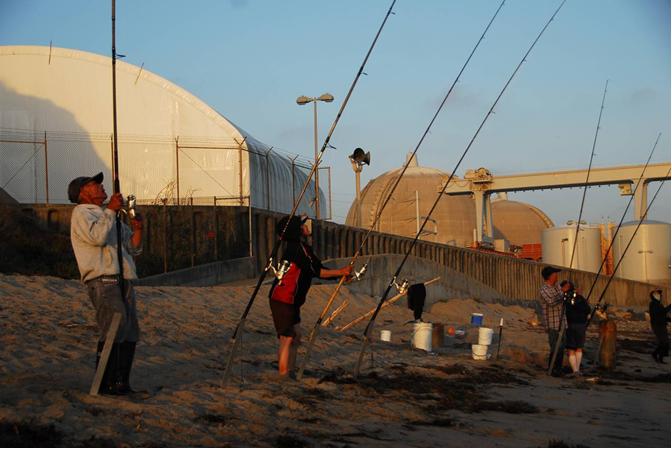
Skeletons in the closet
Leaked Edison document exposes San Onofre as worst in the nation
The crippled steam generators in the San Onofre nuclear reactors have earned the Southern California Edison run plant the dubious distinction as having the most severely defective and damaged of all comparable equipment in the US nuclear industry, according to a recent report by Fairewinds Associates. The report analyses a leaked internal Edison document that reveals damage to thousands of tubes in the new steam generators of both reactors.
The unprecedented problems with this equipment pose a serious safety threat to communities in Southern California. Failure of a single tube in the steam generators can release radiation beyond the protective containment building – as was demonstrated by the tube failure accident and radiation release at San Onofre Unit 3 on January 31st. This event led to the already over five month shut down of both reactors at the site.
According to nuclear expert Arnie Gundersen of Fairewinds, that accident could have been far more severe –and may be just a small prelude to the type of accident that could occur should either reactor be allowed to restart before the problems are understood and fully rectified.
The leaked document reveals that over 4,000 tubes in the steam generators of both reactors are showing wear and thinning as a result of excessive vibration and tube collision. In an effort to mitigate the damage, Edison has plugged 1317 tubes (which prevents tubes from carrying radioactive water). According to Gundersen, plugging the tubes does not stop them from vibrating. In fact, vibrating plugged tubes can still knock into their nearly 3000 unplugged and already damaged neighbors, further exacerbating the thinning. Such damage can cause a tube rupture, which it could create a rapid, domino-like cascading tube accident and a catastrophic release of radiation into surrounding areas where some 8 million people live within 50 miles of the defective plant.
Although Edison has only plugged slightly over a quarter of the tubes that are showing wear at both Unit 2 and Unit 3, this extent of tube plugging has never been conducted for a replacement generator anywhere in the US. In fact, the Fairewinds report reveals that the number of plugged tubes in either San Onofre steam generator exceeds the combined total of plugged tubes at every other replacement steam generator in the country.
In addition to the unprecedented thinning and plugging of the steam generator tubes, eight steam generator tubes failed pressure testing. At a meeting in San Juan Capistrano on June 18th, the Nuclear Regulatory Commission Augmented Inspection Team — special task force deployed to analyze the steam generator problems — revealed that this was the first time more than one tube has ever failed such testing anywhere in the country and that this is a significant safety concern.
This is also the first time that a single steam generator tube constructed of Alloy 690 — a thermally-treated, stronger alloy than that used in older steam generators — had ever failed such testing. Again, not just one, but eight failed. The seriousness of the problems at San Onofre cannot be overstated.
Since the accident at Unit 3 in January, Edison has stated that there are differences between the steam generators of the two San Onofre reactors that would justify restarting reactor Unit 2 even though Edison has not identified let alone solved the root causes that lead to the severe tube deterioration. However, based upon the evidence found in the leaked Edison document, Fairewinds definitively concluded that the damage and causes for failure are the same for the steam generators at both San Onofre reactors.
That the problems with the steam generators in both San Onofre reactors are the same is unsurprising since they were constructed to the same design specifications and used the same faulty computer models — which produced an error margin as high as 400%.
Edison has argued that it be allowed to restart Unit 2 because it is in better condition than its sister unit, which fails to address that the steam generators in both reactors are extraordinarily worse than any other replacement steam generator in the history of the US nuclear fleet.
If an aircraft manufacturer and operator had designed a plane that proved to be the worst in the history of the industry and whose design was tested using models that were off by up to 400%, we certainly wouldn’t allow them to put a patch on the wing and take off again – particularly if that aircraft were carrying a potentially catastrophic, radioactive load.
In order to ensure the safety of the public, it is imperative that neither San Onofre reactor be permitted to restart with a patch fix on a dangerously and exceptionally flawed design.
To this end, Friends of the Earth filed a petition with the NRC requesting that the commission require that Edison submit to the license amendment process — which should have been conducted under NRC regulations when this drastically altered equipment was initially designed —for their steam generators. This process would require an adjudicatory public hearing and ensure that all issues are uncovered and rectified prior to restarting either reactor. The NRC has not yet responded to the petition.
However, the NRC’s Augmented Inspection Team is expected to release its final report on the steam generator problems within days. It is critical to note that the problems at San Onofre are due both to Edison’s misrepresentation of the magnitude of the steam generator design changes and the NRC’s failure to recognize the significance of the design modifications and require that Edison comply with their own regulations. Friends of the Earth is committed to continuing to hold both the NRC and Edison accountable for their failure to adequately address the root causes of the extraordinary problems at San Onofre and ensure that the reactors are not restarted unless public safety can be guaranteed.
Related Posts
Ways to Support Our Work

Read Latest News
Stay informed and inspired. Read our latest press releases to see how we’re making a difference for the planet.

See Our Impact
See the real wins your support made possible. Read about the campaign wins we’ve fought for and won together.

Donate Today
Help power change. It takes support from environmental champions like you to build a more healthy and just world.